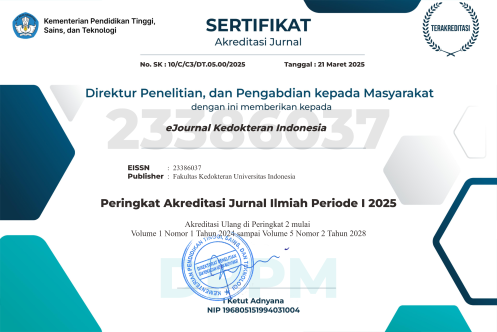Predicting Urinary Incontinence among Postpartum Women
DOI:
https://doi.org/10.23886/ejki.11.223.263Keywords:
urinary incontinence, postpartum, risk factorsAbstract
Urinary incontinence (UI) is common during a pregnancy-puerperium period, with a prevalence of 18.6-75% during pregnancy and 6-31% during postpartum. This study aims to review several published studies on which risk factors impact the incidence of UI.The search was conducted on Pubmed®, Cochrane Library®, and Ovid®, resulted in 57, 30, and 11 studies, respectively. We included cross-sectional, cohort, or case-control studies related to this aim. The risk of bias within the study was assessed using the Cochrane and Forrest plot was analysed using Review Manager 5.3. On maternal characteristics, age less than 35 years (OR 0.49; 95% CI 0.35-0.67), primiparity (OR 0.29; 95% CI 0.22-0.38), and BMI <25 kg/m2 (OR 0.67; 95% CI 0.55-0.83) were considered as protective factors. A low level of education (OR 2.16; 95% CI 1.69-2.77) increased the risk of UI, Meanwhile, they showed heterogeneity among studies (I2>50%). On delivery methods, the most prone to UI was emergency caesarean section followed by instrumental vaginal deliveries, spontaneous vaginal deliveries, and caesarean section. Episiotomy, epidural analgesia, and obstetric anal sphincter injury (OASIS) were not associated with UI (p>0.05). On neonatal parameters, head circumference <35 cm has a protective effect on UI (OR 0.82; 95% CI 0.73-0.93; I2=0%). Methods of delivery and head circumference will affect postpartum UI according to p-value (p<0.05) and homogeneity among studies (I2<50%).
Downloads
Downloads
Published
How to Cite
Issue
Section
License
Copyright (c) 2023 Surahman Hakim, Raymond Surya, Astrid Yunita, Gita Nurul Hidayah, Budi Iman Santoso

This work is licensed under a Creative Commons Attribution-NonCommercial 4.0 International License.
Accepted 2023-12-14
Published 2023-12-29



